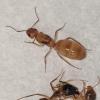I know that Camponotus species are sometimes referred to having 3 different worker castes; Minor, media (aka Intermediate) and major. How do I identify a media worker? I cannot any literature out there about the unique morphological characters of this caste that seperates them from minor and major, except that they are a bit larger than minors. Any easier ways?
- Formiculture.com
- Forums
- Gallery
- Members
- Member Map
- Chat





















